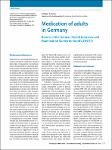Medication of adults in Germany
Results of the German Health Interview and Examination Survey for Adults (DEGS1)
Knopf, Hildtraud
Grams, Daniel
The first wave of the German Health Interview and Examination Survey for Adults, 2008–2011 (DEGS1), assesses current medicine use among participating adults aged 18–79 years in the 7 days prior to the medical examination as part of a standardised interview. About three quarters (74.4%) of all men and women state that they used at least one preparation. Prevalence is highest among 70–79 year olds (men 94.9%; women 96.3%). Overall women have a significantly higher prevalence rate (85.4%) than men (63.8%). Preparations for the treatment of cardiovascular diseases are the most frequently used medicines (men 27.2%; women 29.5%). Polypharmacy (the use of 5 or more preparations) increases continuously with age and is observed significantly more often in women than in men in all age groups with the exception of the age group 70–79. Of the 20,084 recorded preparations, 71.8% are prescribed by a doctor and 27.7% are self-medicated. While there are no differences in overall medication linked to social status, a social gradient is observed in prescribed preparations and self-medication. The results presented here describe key indicators of medication use representative of the German adult population. Based on the extensive data of DEGS1, further analyses into aspects such as co- and multimedication will be addressed in the future.
Dateien zu dieser Publikation
Keine Lizenzangabe

